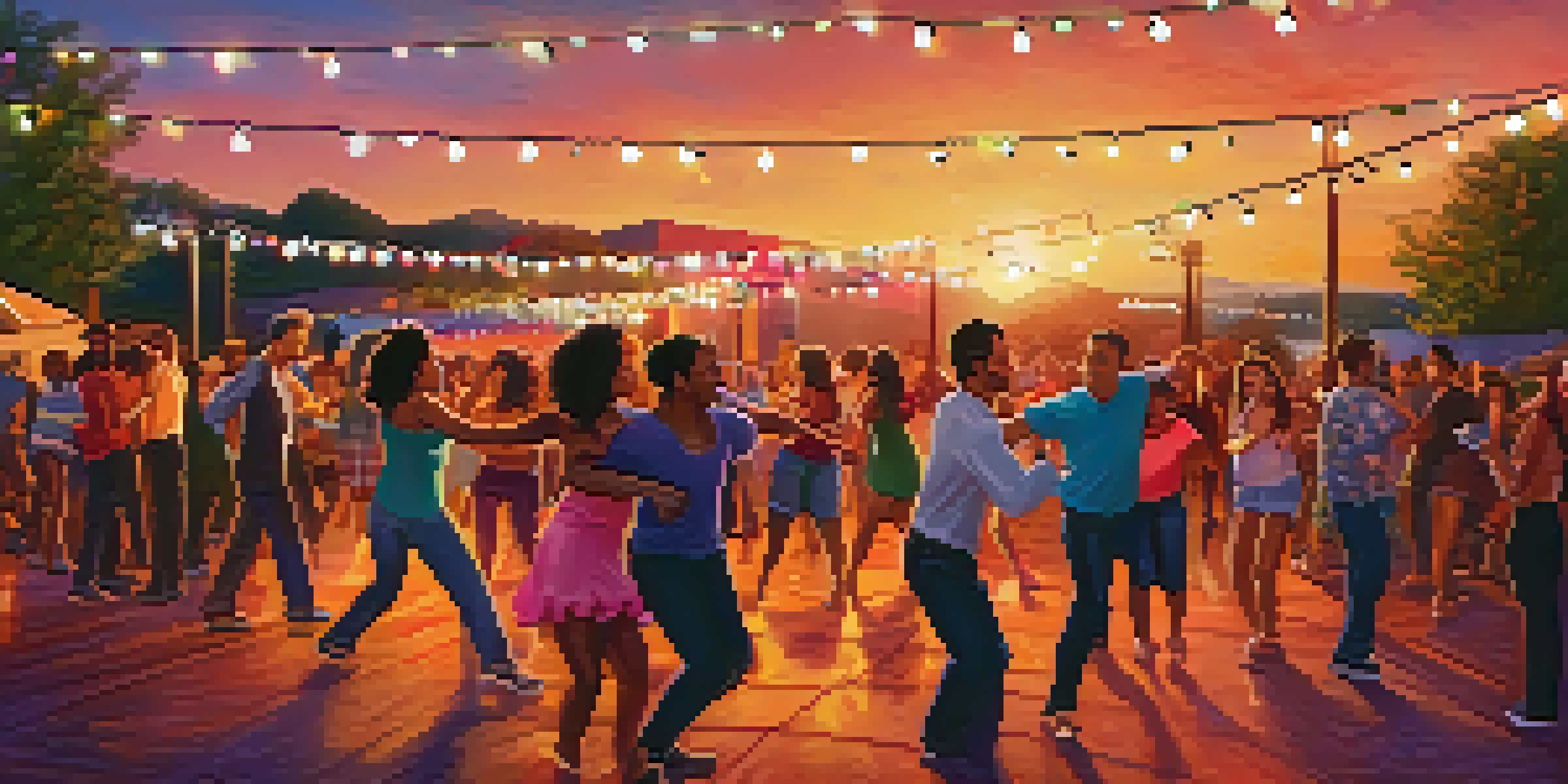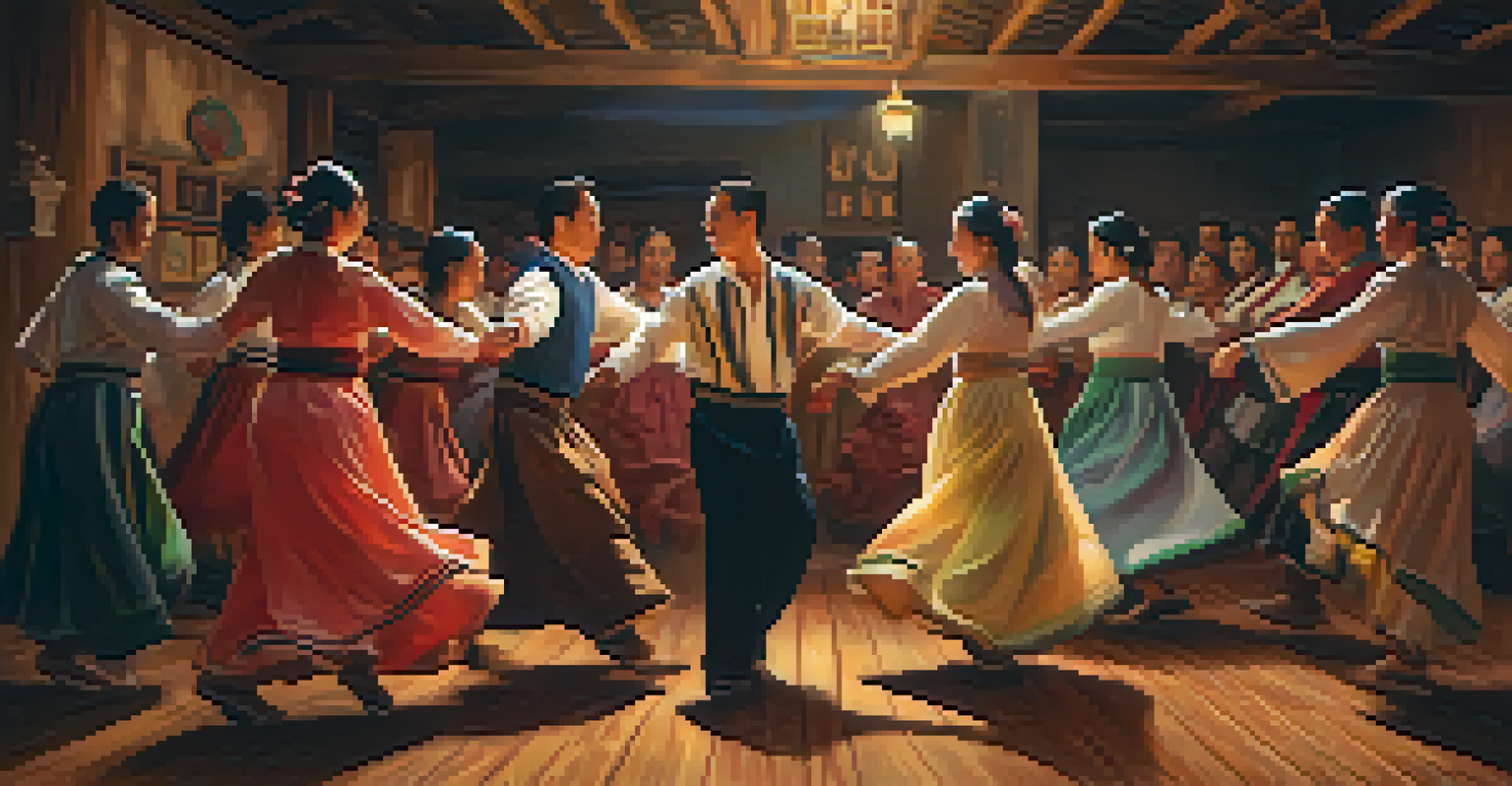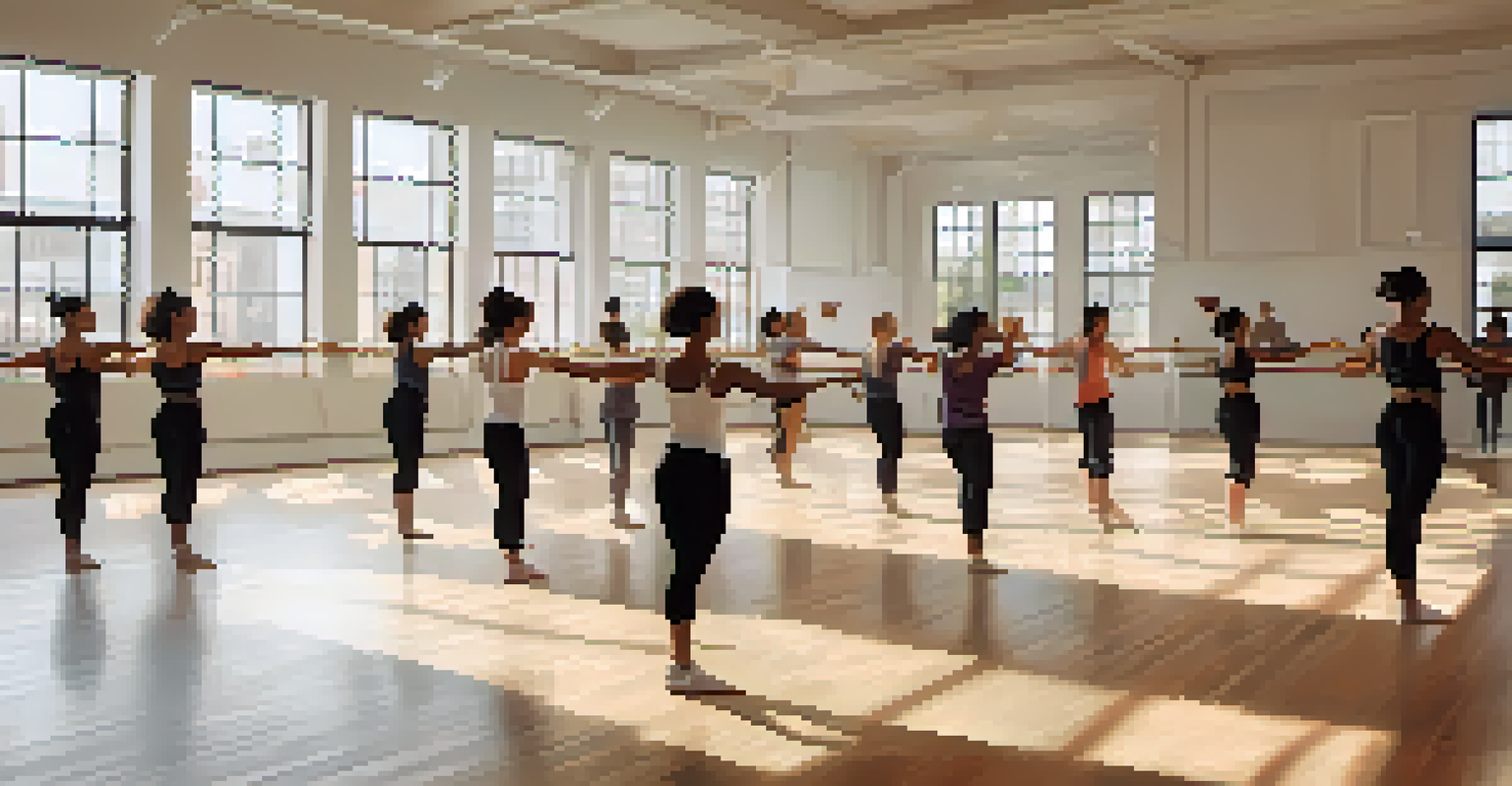The Impact of Social Dance on Community Building and Bonds

Social Dance: A Unifying Force in Communities
Social dance has long been a vibrant part of human culture, acting as a bridge between various groups. Whether it's a community salsa night or a traditional folk dance, these gatherings provide a space where people can come together, regardless of their backgrounds. This unifying effect is particularly important in our increasingly fragmented society, where personal connections can often feel strained or superficial.
Dance is the hidden language of the soul.
When people participate in social dance, they engage in a shared experience that fosters camaraderie and mutual respect. The act of dancing together breaks down barriers, allowing individuals to express themselves in ways that words often cannot. This sense of belonging and shared joy creates an atmosphere where friendships can blossom, making communities feel more like family.
Moreover, social dance can serve as a catalyst for cultural exchange, introducing participants to diverse traditions and practices. This not only enriches individual experiences but also strengthens community bonds by highlighting commonalities amidst differences. As a result, social dance becomes a celebration of diversity, weaving a rich tapestry of shared history and collective identity.
Building Trust Through Movement and Rhythm
Trust is a vital component of any strong community, and social dance provides a unique venue for building it. The physical act of dancing often requires cooperation and communication, which helps cultivate trust among participants. When people learn to move together, they develop a sense of reliance on one another, fostering deeper connections that extend beyond the dance floor.

In social dance settings, individuals often find themselves in unfamiliar roles, whether as a leader or a follower. This dynamic encourages empathy, as dancers must be attentive to their partner’s movements and intentions. By navigating these roles together, participants learn to appreciate different perspectives, ultimately enhancing their interpersonal relationships within the community.
Social Dance Unites Communities
Social dance fosters connections among diverse groups, creating a sense of belonging and shared joy.
Additionally, trust built through social dance can lead to wider community engagement. Participants are more likely to support one another in various endeavors, from local initiatives to personal projects. This sense of solidarity transforms social dance from a mere recreational activity into a foundation for collective action and community resilience.
Social Dance as a Tool for Cultural Preservation
Many social dance forms are deeply rooted in cultural traditions, serving as a means of preserving heritage. Through dance, communities can pass down stories, values, and customs from one generation to the next. This transmission not only maintains cultural identity but also enriches the community’s social fabric.
Dancing is like dreaming with your feet.
Engaging in traditional dances allows participants to connect with their history and understand their place within it. In turn, this understanding fosters pride in one’s heritage, encouraging community members to become active stewards of their culture. By preserving these practices, social dance helps to ensure that future generations remain connected to their roots.
Moreover, cultural preservation through dance invites dialogue and learning among diverse groups. When different communities share their dance traditions, they create opportunities for collaboration and mutual respect. This exchange not only strengthens cultural bonds but also promotes a broader understanding of the rich tapestry of human expression.
The Role of Social Dance in Mental Health and Well-being
Participating in social dance can have profound effects on mental health and overall well-being. The joy of movement, combined with the social interactions that come with dancing, releases endorphins, which are known as the body's natural mood lifters. This positive impact can be particularly significant in communities facing challenges, as dance offers a healthy outlet for stress relief and emotional expression.
In addition to improving mood, social dance fosters a sense of belonging, which is crucial for mental health. When individuals feel connected to a community, they are more likely to experience lower levels of anxiety and depression. The shared laughter and moments of joy during dance create an environment where people can feel safe and supported.
Trust and Empathy Through Dance
Participating in social dance cultivates trust and empathy, enhancing interpersonal relationships within communities.
Furthermore, social dance can enhance cognitive function by requiring participants to remember steps, rhythms, and patterns. Engaging the mind in this way promotes mental agility and can even delay cognitive decline as individuals age. Thus, social dance not only nourishes the body but also strengthens the mind, contributing to a holistic approach to community health.
Creating Safe Spaces Through Social Dance
One of the remarkable aspects of social dance is its ability to create safe, inclusive spaces for all. These environments encourage individuals to express themselves freely without fear of judgment or rejection. By establishing such spaces, communities can foster a sense of security that invites participation from everyone, regardless of their skill level or background.
In these welcoming settings, participants can explore their identities and share personal stories through movement. This freedom of expression allows for authentic connections, as individuals bond over shared experiences and vulnerabilities. The safety of these spaces not only nurtures individual growth but also strengthens the community's collective identity.
Moreover, the presence of safe spaces in social dance can empower marginalized groups. By providing a platform for underrepresented voices, communities can celebrate diversity and promote inclusivity. This commitment to creating a welcoming atmosphere ensures that social dance remains a powerful tool for building strong, resilient communities.
Social Dance as a Catalyst for Local Economic Growth
Beyond its social benefits, social dance can also contribute to local economic growth. Dance events often attract participants from various areas, leading to increased foot traffic in local businesses such as restaurants, shops, and venues. This influx can provide a much-needed boost to the local economy, creating a win-win situation for everyone involved.
Moreover, social dance events can create job opportunities for instructors, DJs, and event organizers, contributing to the overall economic health of the community. As these events gain popularity, they may also attract sponsors and funding, further enhancing community resources. This economic ripple effect underscores the multifaceted impact of social dance on community well-being.
Economic Growth via Dance Events
Social dance events stimulate local economies by increasing foot traffic and creating job opportunities.
Additionally, local dance initiatives can promote entrepreneurship by encouraging participants to start their own dance studios or businesses related to dance. This entrepreneurial spirit not only stimulates economic growth but also inspires creativity and innovation within the community. As such, social dance serves as both a cultural and economic catalyst, enhancing the community's vibrancy.
The Future of Social Dance in Community Building
As we look to the future, the role of social dance in community building is set to evolve further. With advancements in technology and the rise of virtual gatherings, communities can connect through dance in new and innovative ways. Online platforms enable individuals to participate in dance events from the comfort of their homes, expanding accessibility and inclusion.
However, while technology offers exciting possibilities, the essence of social dance as a face-to-face, communal experience remains vital. Communities must find a balance between embracing digital advancements and nurturing in-person connections. This dual approach can enhance the impact of social dance on community building by reaching more people and creating deeper bonds.

Ultimately, the future of social dance lies in its ability to adapt and resonate with diverse audiences. By continuing to celebrate cultural heritage, foster inclusivity, and create safe spaces, social dance will remain a powerful tool for community building, ensuring that connections will flourish for generations to come.